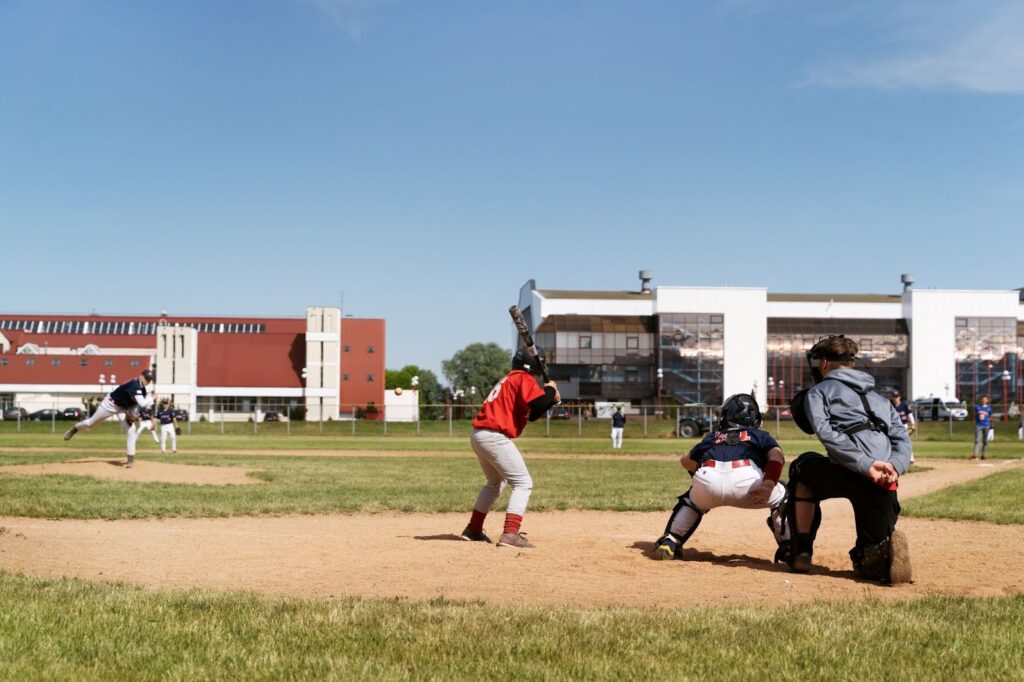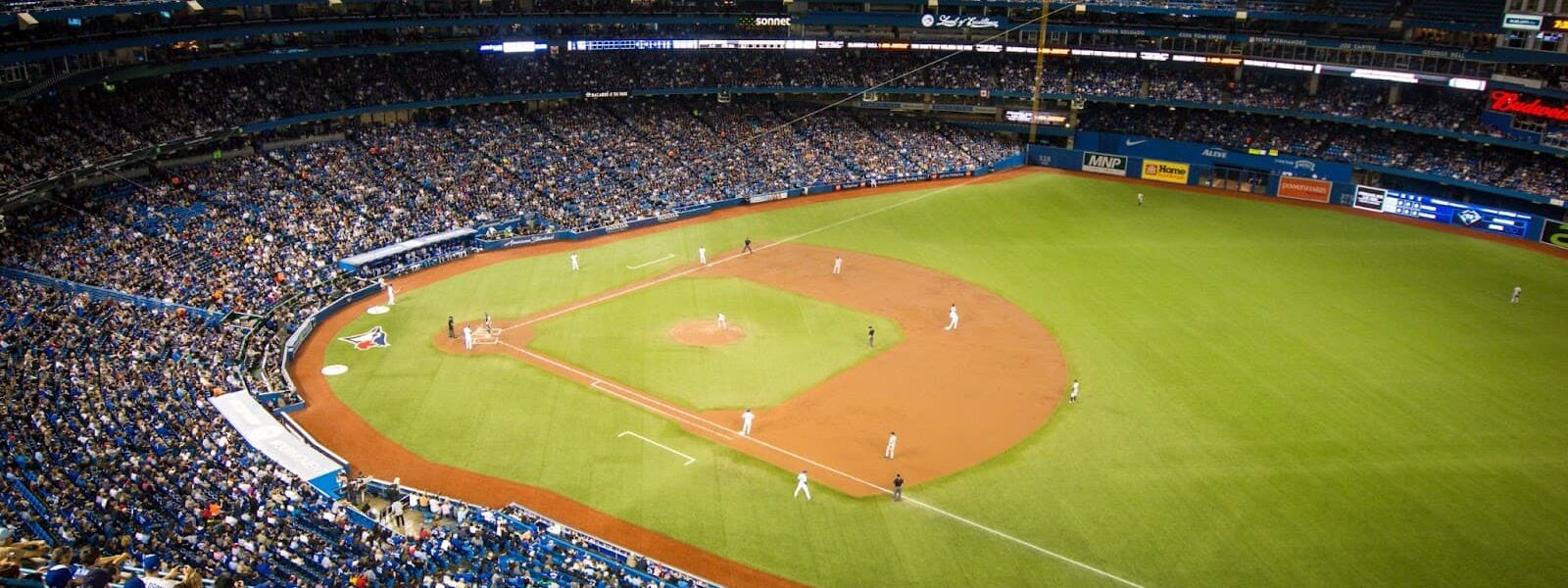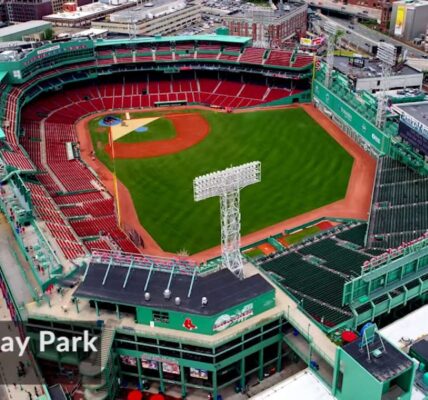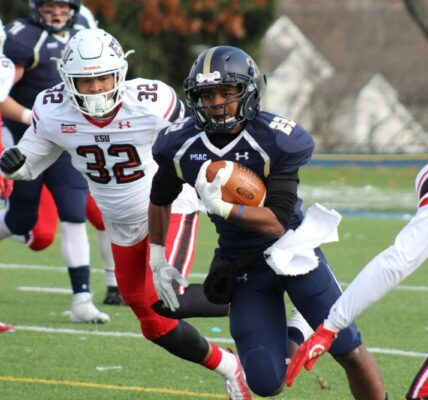In the realm of sports, Major League Baseball (MLB) proudly showcases a collection of stadiums that have attained iconic status. Below, we present a ranking of MLB’s grandest stadiums, organized according to their seating capacities.
Oakland Coliseum: A Pantheon Among Baseball Stadiums
Holding the title of the largest Major League Baseball (MLB) stadium, the Oakland Coliseum stands grand and proud with a staggering seating capacity of 56,782. The stadium garners attention not only for its imposing size but also for being the home ground to the renowned Oakland Athletics.
The Oakland Coliseum, rich in history and teeming with fervor, has been the backdrop for countless remarkable moments in baseball history. One such memorable event stamped in the annals was the Athletics’ stunning victory over the Chicago White Sox by a decisive 10-2 score. This game, held as part of the 50th-anniversary celebrations at the Coliseum, etched a memorable story in the minds of all spectators, forever ingraining the sheer dominance of the Athletics on their home turf.
Moreover, the Oakland Coliseum is versatile in its usage. Besides being the nerve center for baseball games, it also serves as the home field for the Oakland Raiders, contributing significantly to the National Football League (NFL).
Dodger Stadium: Showcasing Baseball Brilliance in Los Angeles
Nestled in the heart of Los Angeles, California, lays the Dodger Stadium, an architectural marvel that has been the staging ground for some of MLB’s most intense and exciting games. The stadium, with an impressive capacity of 56,000, is the second-largest baseball stadium in the United States and is the home field for the illustrious Los Angeles Dodgers.
Dodger Stadium is not just a physical structure; it is a repository of tradition, history, and milestones. In its 57 years of existence, the stadium has been a silent witness to twelve no-hitters, a spectacle that every baseball fan eagerly anticipates. Two of these games were perfect games, a testament to the Dodger’s prowess and the exhilarating level of competition the stadium has seen.
Serving as a beacon of baseball culture and history, Dodger Stadium continues to pay homage to the spirit of the sport while showcasing the best of MLB. Also, discover the surprising numbers behind how many baseballs are used in an MLB season. Dive into the stats and secrets of America’s favorite pastime!
Chase Field: A Modern Marvel in the Heart of Arizona
Positioned majestically in the heart of Phoenix, Arizona sits Chase Field, a top-tier baseball stadium that houses the National League’s Arizona Diamondbacks. With a seating capacity for a whopping 48,405 audience members, Chase Field secures its place as the fifth-largest baseball stadium across the United States.
The Diamondbacks chose to enhance their home field advantage in 2019, forfeiting their natural grass turf for an innovative synthetic surface. This strategic decision showcases the team’s commitment to advancing with technology as synthetic turf has increased durability, requires less maintenance, and holds up better in the Arizona heat, ensuring optimal playing conditions year-round.
Beyond baseball, Chase Field is a hub of entertainment hosting a range of events, including concerts and food festivals. It boasts an array of amenities for fans, from a wide variety of food stalls to private event spaces.
Key Features of Chase Field:
- Seating capacity: 48,405;
- Home team: Arizona Diamondbacks;
- Choice of synthetic surface for better durability and low maintenance;
- Hosts a wide range of events beyond baseball.
T-Mobile Park: Seattle’s Crown Jewel of Recreation
Nestled within the bustling city of Seattle, Washington, T-Mobile Park stands as a testament to modern stadium design. It serves as home ground for the Seattle Mariners, accommodating nearly 47,929 spectators and securing its position as the sixth-largest baseball stadium in the United States.
The stadium was formerly known as Safeco Field, but underwent a rebranding after Safeco chose not to renew the naming rights deal. Despite the change in name, the stadium continues to be a beloved part of Seattle’s landscape and a favorite among local and visiting baseball fans alike.
T-Mobile Park possesses a retractable roof, ensuring games can proceed unaffected by Seattle’s infamous rainfall. This illustrates the stadium’s dedication to providing a seamless game experience. Moreover, it offers an array of eating options and a stunning view of Seattle’s skyline, enhancing the overall visitor experience.
Key Features of T-Mobile Park:
- Seating capacity: 47,929;
- Home team: Seattle Mariners;
- Equipped with a retractable roof to combat Seattle’s rainfall;
- Previously known as Safeco Field;
- Stunning Views of Seattle’s skyline;
- Diverse food options for spectators.
Exploring the Classic: Oriole Park at Camden Yards
Situated in the heart of Baltimore, Maryland, Oriole Park at Camden Yards is an iconic baseball stadium that serves as a home ground for the Baltimore Orioles. Boasting a capacity of 45,971 seats, it proudly stands as the eighth largest baseball stadium in the United States.
Established in 1992, the ballpark replaced the older Memorial Stadium, spearheading a trend of ‘retro’ styled facilities that married old-world charm with modern amenities. The unique blend of history and innovation in its construction demonstrates Oriole Park’s commitment to retaining the essence of the sport while delivering an enhanced spectator experience.
Unbeknownst to many, Oriole Park at Camden Yards has also graced the screen, appearing in popular TV series such as “House of Cards” and “The Wire”, thereby securing its place not just in sports history, but also in the world of entertainment.
Features of Oriole Park at Camden Yards:
- Seating Capacity: 45,971;
- Home Team: Baltimore Orioles;
- Built in a ‘retro’ style, blending traditional charm with modern comfort;
- Has made appearances in TV shows including “House of Cards” and “The Wire”.
The Big A: Angel Stadium of Anaheim
Located in sunny Anaheim, California, Angel Stadium of Anaheim, or as it’s fondly known, ‘The Big A’, is an impressive sports structure, holding up to 45,517 fans for each game. This makes it the ninth largest stadium in the United States.
The stadium is the home of the Los Angeles Angels of the Major League Baseball (MLB). Charming for its compact yet comfortable aesthetics, the stadium’s intimacy allows fans to feel closer to the action on the field. The Big A has also played witness to history, hosting the 1967 Major League Baseball All-Star game, the first-ever to be broadcasted in primetime television.
In another notable milestone, Angel Stadium of Anaheim is set to host both baseball and softball games during the 2028 Olympics, further cementing its significant role in the realm of sports.
Features of Angel Stadium of Anaheim:
- Seating Capacity: 45,517;
- Home Team: Los Angeles Angels;
- Also known as ‘The Big A’;
- Was the venue for the 1967 Major League Baseball All-Star game;
- Set to host baseball and softball games during the 2028 Olympics.
An Ode to the Phillies: Citizens Bank Park
Rooted in the heart of Philadelphia, Citizens Bank Park serves as the playing field for the city’s much-loved Philadelphia Phillies. The stadium, with a generous seating capacity of 42,792, made its debut in 2004, replacing the iconic Veterans Stadium.
Citizens Bank Park plays a pivotal role in the South Philadelphia Sports Complex, sharing the limelight with other major sports venues like the Lincoln Financial Field and Wells Fargo Center. Its baseball-centric design, replete with asymmetrical seating arrangement and a natural grass surface, presents spectators with an unmatched viewing experience.
The Ashburn Alley at the stadium, honoring Hall of Famer Richie Ashburn, is a must-visit for fans. Here, one can find numerous eateries, games, and a walk of fame, adding a unique charm to the visitor experience.
Features of Citizens Bank Park:
- Seating Capacity: 42,792;
- Home Team: Philadelphia Phillies;
- Baseball-centric design with a natural grass surface;
- Part of the South Philadelphia Sports Complex;
- Ashburn Alley featuring eateries, games, and a walk of fame.
The Rays’ Fortress: Tropicana Field
Tropicana Field, situated in St. Petersburg, Florida, holds the distinction of being the home ground for the Tampa Bay Rays. Established in 1990, it’s admired for its distinctive architectural features, including a fixed, slanted roof and catwalks.
The infield and outfield are covered with a blend of Kentucky bluegrass and perennial ryegrass while the rest of the field is surfaced with FieldTurf, an artificial turf. The stadium’s unique design ensures that baseball games can transpire unhindered, irrespective of Florida’s unpredictable weather.
Beyond baseball, the stadium also hosts other sporting events, concerts, and consumer shows, making it a critical center for recreation and entertainment in the city.
An interesting feature of Tropicana Field is the Rays Touch Tank, a 10,000-gallon tank featuring rays collected from the Tampa Bay area, presenting a novel experience to visitors.
Features of Tropicana Field:
- Seating Capacity: 25,000 (Baseball configuration), 42,735 (Full stadium configuration);
- Home Team: Tampa Bay Rays;
- Distinctive fixed, slanted roof and catwalks;
- Field surfaced with a mix of natural and artificial turfs;
- Hosts multiple sporting events, concerts, and consumer shows;
- Features a Rays Touch Tank offering a unique interactive experience.
Embracing the Mets: Citi Field
Nestled in the vibrant borough of Queens, New York City, Citi Field stands proud as the home sweet home for the New York Mets since its inauguration in 2009. The stadium, designed by architectural firm Populous, is reminiscent of the classic Ebbets Field in Brooklyn, bridging a nostalgic past with the vibrant present.
Citi Field, with a seating capacity of 41,922, is characterized by its distinct orange-hued foul poles standing tall in contrast against the lush green field. One of the highlights of the stadium’s timeline was hosting the 2013 MLB All-Star Game, a significant event in baseball annals.
Features of Citi Field:
- Seating Capacity: 41,922;
- Home Team: New York Mets;
- Architecture inspired by Brooklyn’s Ebbets Field;
- Unique orange foul poles;
- Hosted the 2013 MLB All-Star Game.
A Tribute to the Giants: Oracle Park
Tucked within San Francisco’s bustling SoMa district, Oracle Park is an iconic sporting fixture in the city. Since 2000, it has been a second home for the San Francisco Giants. The stadium, known previously as Pacific Bell Park, SBC Park, and AT&T Park, received its current name from Oracle Corporation in 2019.
Oracle Park’s location, in close proximity to the San Francisco Bay, gives it a unique charm. The picturesque McCovey Cove beyond its right field wall ensures that spectators are treated not only to an excellent game, but also a beautiful backdrop.
The park is infamous for its “Splash Hits”, which count the number of home runs hit by Giants that land in the Bay, offering an exciting element to the matches.
Features of Oracle Park:
- Seating Capacity: 41,265;
- Home Team: San Francisco Giants;
- Proximity to the San Francisco Bay and the iconic McCovey Cove;
- Infamous for its “Splash Hits”;
- Renamed Oracle Park in 2019 from AT&T Park.
Unraveling the Charm of Wrigley Field
Wrigley Field, an emblem of baseball history, is cocooned within the vibrant neighborhood of Lakeview in Chicago. Serving as the home ground for the Chicago Cubs since 1916, this stadium’s vintage aesthetics and timeless appeal continue to enchant fans. With a seating capacity of 41,649, it stands as one of the oldest parks in Major League Baseball (MLB).
What sets Wrigley Field apart are its ivy-covered outfield walls, its iconic red marquee entrance, and its hand-turned scoreboard, aspects that exude a sense of nostalgia. Whether it’s the famous “The Wave” by fans or singing “Take Me Out to the Ball Game” during the 7th-inning stretch, this stadium offers an experience that transcends beyond baseball.
Features of Wrigley Field:
- Seating Capacity: 41,649;
- Home Team: Chicago Cubs;
- One of MLB’s oldest parks;
- Iconic ivy-covered outfield walls and hand-turned scoreboard;
- Famed for fan traditions like “The Wave” and 7th-inning stretch song.
Discovering Nationals Park
Situated in the heart of Washington, D.C., Nationals Park serves as the battleground for the Washington Nationals. Opened its gate in 2008, it ushers in 41,339 spectators, bringing together baseball lovers from all walks of life.
The park is renowned for its eco-friendly design and sustainable practices, which led to its LEED Silver Certification. From an array of dining options to numerous amenities and fan activities, Nationals Park promises a fulfilling experience to every visitor.
Features of Nationals Park:
- Seating Capacity: 41,339;
- Home Team: Washington Nationals;
- Eco-friendly design led to LEED Silver Certification;
- Rich in meals options, amenities, and fan activities.
A Stroll Through Minute Maid Park
Minute Maid Park, the pride of Houston, Texas, is the dynamic home field for the Houston Astros. This modern stadium, which opened in 2000, accommodates an audience of 41,168, complete with a retractable roof to counter the Texan weather.

The stadium offers a beautiful view of Houston’s downtown skyline from certain sections of the park, further enhancing the spectator experience. An additional allure is the vintage, full-sized locomotive that runs along an 800-foot track on the left-field wall, celebrating the railroad’s contribution to Houston’s history.
Features of Minute Maid Park:
- Seating Capacity: 41,168;
- Home Team: Houston Astros;
- Retractable roof stadium;
- Stunning view of Houston’s downtown skyline;
- Features a vintage, full-sized locomotive.
Unveiling the Magic of Guaranteed Rate Field
Guaranteed Rate Field, an impressive sports venue nestled in Chicago, has been serving as the Chicago White Sox’s playground since its inauguration in 1991. Known for its architectural elegance and contemporary design, the park can cater to 40,615 spectators, offering them an immersive baseball experience.
Experiencing a string of name changes due to sponsoring partners, it finally landed on the name ‘Guaranteed Rate Field’ in 2016. The field is appreciated for its intimate seating, giving fans a close view of the on-field action. It also offers an array of delightful cuisines from local Chicago eateries.
Features of Guaranteed Rate Field:
- Seating Capacity: 40,615;
- Home Team: Chicago White Sox;
- Transitioned through multiple names due to sponsorships;
- Known for its intimate seating and diverse local food options.
Embarking on the Journey of Globe Life Field
Globe Life Field, located in the heart of Arlington, Texas, proudly serves as the home field for the Texas Rangers. This modern marvel, which debuted in 2020, can accommodate 40,300 spectators under its retractable roof, a feature added to adapt to Texas’ fluctuating weather.
Globe Life Field offers an extensive selection of food and beverage options, multiple fan zones, and family areas, promising an engaging experience for every spectator.
Features of Globe Life Field:
- Seating Capacity: 40,300;
- Home Team: Texas Rangers;
- Features a retractable roof for weather adaptability;
- Offers extensive dining options and multiple fan zones.
Experiencing the Splendor of Petco Park
Petco Park, majestically located in sunny San Diego, is the playground for the San Diego Padres. Since its grand unveiling in 2004, it has been a preferred destination for 40,209 baseball enthusiasts wanting to catch a Padres game.
The park’s allure lies not just in the riveting games, but also in its breathtaking views of the San Diego Bay and the city’s skyline. Its extensive range of local food and craft beer offerings, coupled with the engaging in-park entertainment, makes a visit to Petco Park a complete recreational package.
Features of Petco Park:
- Seating Capacity: 40,209;
- Home Team: San Diego Padres;
- Offers stunning views of the San Diego Bay and city skyline;
- Presents a diverse range of local food and craft beer options.
Conclusion
In conclusion, Major League Baseball (MLB) stands as a testament to the grandeur and history of sports, with its array of iconic stadiums that continue to captivate fans around the world. This ranking of MLB’s largest stadiums based on seating capacity highlights the immense diversity and passion that exists within the sport, inviting fans to gather and share unforgettable moments in these hallowed arenas.




